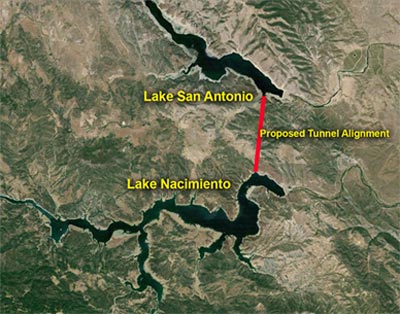Governor approves $10 million for Nacimiento-San Antonio tunnel

–Governor Jerry Brown this week signed Senate Bill 831 allocating $10 million from the state’s general fund for construction of an interlake tunnel from Lake Nacimiento to Lake San Antonio in Monterey County.
The Interlake Tunnel will divert water from Nacimiento Reservoir to the San Antonio Reservoir that would have otherwise been spilled at the Nacimiento Dam, according to the Monterey County Water Resources Agency. The Nacimiento River basin produces nearly three times the average annual flow of the San Antonio River basin. Capturing high Nacimiento River flows and diverting those flows to San Antonio Reservoir increases the overall storage capacity of the system, the agency says. It could add more than 20,000 acre-feet of water per year, according to a report.
“SB 831 is crucial to Monterey County and I want to thank the governor for signing the bill,” said State Senator Bill Monning, who represents San Luis Obispo and Santa Cruz counties, and portions of Monterey and Santa Clara counties.
“The allocation of the $10 million for the construction of the Interlake Tunnel will improve water reliability and provide flood control to the region, as well as provide environmental and economic benefits to the Salinas Valley.” Monning said has been working closely with Senator Anthony Cannella and Assemblyman Luis Alejo, and other regional stakeholders for a number of years to advance this project. “I am extremely pleased that it will now be moving forward.”
The Interlake Tunnel is planned to consist of an 11,000 foot gravity flow tunnel with an intake structure in Nacimiento Reservoir and an exit structure in San Antonio. Total project cost is estimated at $48 million, according to the Monterey County Water Resources Agency. Though some estimates are as high as $76 million. The remainder of the project cost would be paid through a property-based assessment on Salinas Valley beneficiaries of the tunnel.
Depending upon the degree of environmental documentation required the Interlake Tunnel could be completed in two to three years, the agency says.
Click here for current lake levels









